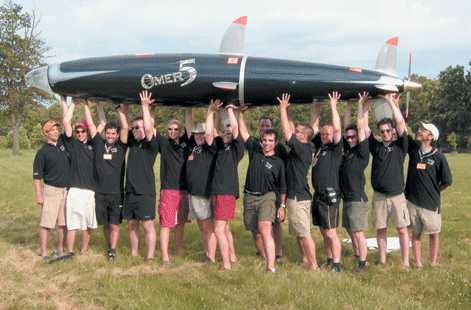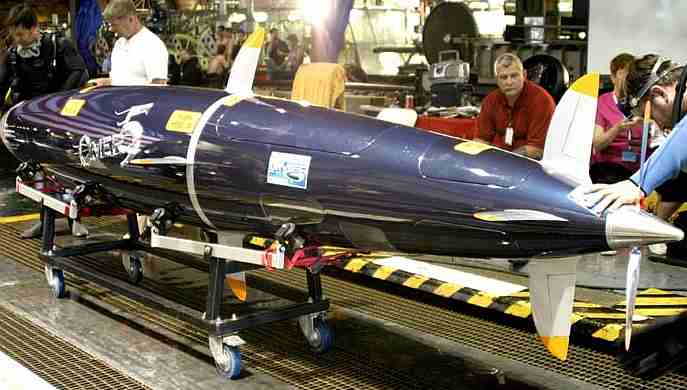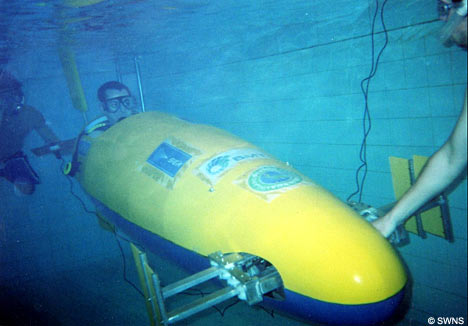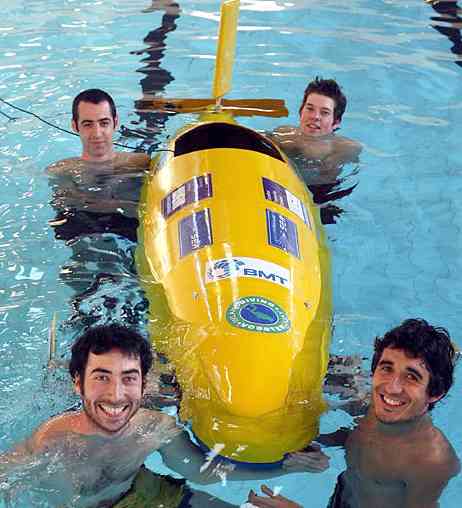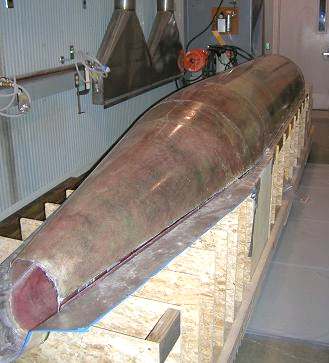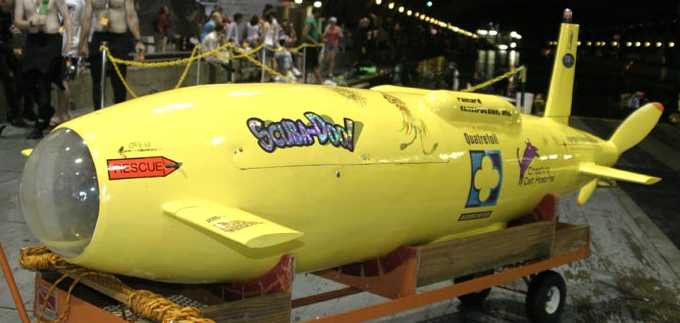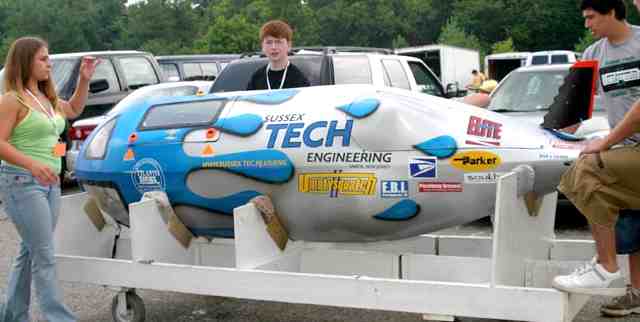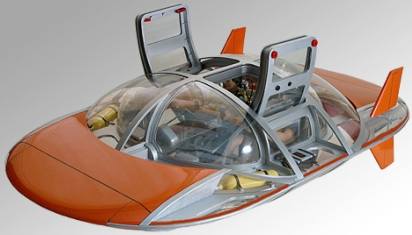|
PEDAL POWERED SUBMARINES - 27 APRIL 2007
|
|
HOME | BIOLOGY | FILMS | GEOGRAPHY | HISTORY | INDEX | INVESTORS | MUSIC | SOLAR BOATS | SPORT |
|
9th INTERNATIONAL SUBMARINE RACES 25 JAN 2007
CARDEROCK, MD. Jan. 19, 2007 -New world speed records are expected to be set when 25 human-powered submarines race against the clock in the 9th International Submarine Races June 24-29, a biennial engineering design competition that challenges the creativity of ocean engineering students, inventors and entrepreneurs.
Omer 5 - Human powered submarine, Quebec University
Omer 5 - World record holder two man submarine, Canada
School Teams Registering for 2007: NOTE: Anyone wanting to order a copy of the ISR8 poster should contact Barbara Anderson at 703-356-0654.
About the RacesThe first human-powered International Submarine Race TM (ISR) was held in 1989 off Riveria Beach, Florida and drew 17 boats. The race grew to 35 boats in 1991 and 44 contestants for the 1993 race off Fort Lauderdale, Florida. The 1995 event (the first ISR indoors) at the Naval Surface Warfare Center (David Taylor Model Basin) drew 11 entrants. The 1997 event at David Taylor drew 16 boats. Each team must develop a one or two-person "Wet" submarine. Two-person subs must have one person providing the propulsion and the other navigating and steering. Both crew members breathe SCUBA from the air supply carried aboard. Each sub is unique, designed from "scratch," and relies upon novel techniques for propulsion and guidance.The International Submarine Race's TM specific goals are:
Participants include universities, corporations, government agencies, individuals and research labs. Various awards are given out at each ISR, including ones for best overall performance, innovation, speed, best use of composite materials and spirit of the race. Volunteers are encouraged and welcome! Summary
Photos
OrganizerISR Organization, Foundation for Underwater Research and Education
BATH UNIVERSITY UNITED KINGDOM
A team of university boffins have designed Britain's first human-powered submarine. The 10ft-long vessel carries one "pilot" who pedals a contraption similar to an exercise bike, reaching speeds of more than three knots (3.5mph).
SeaBomb, was designed and built by a team of final-year engineering undergraduates from Bath University
The SeaBomb, was designed and built by a team of final-year engineering undergraduates from Bath University as their degree project.
In June they will take their machine to compete against 24 American subs in the International Submarine Races at a US Navy training base in Maryland.
The team are the only Europeans in the competition and aim to wrestle the underwater speed crown from the Americans for the first time.
Brainy Rob Templeton, 22, who hopes to pilot the craft, said the team were following a proud British tradition.
He said: "We are right up there in a great tradition of wacky British inventors.
"We're not sure what the Americans might come up with but, from the trials we've done, we're confident get can get it up to a very competitive speed.
"The only difficult thing is keeping it going in a straight line."
The SeaBomb is 10ft, three feet wide, three feet high and weighs 100 kilogrammes when dry.
However, it is a "wet" submarine, which means it is full of water when it moves and it then weighs 750kg to remain neutrally buoyant and not sink or float.
It moves as the pilot, who is reclined on an exercise bike-style machine, pumps pedals attached to pistons, while breathing using scuba kit.
The 10ft-long vessel carries one "pilot" who pedals a contraption similar to an exercise bike
The pistons power a "whale drive", designed by Rob, which moves four flexible fins at the front of the sub, which are much more energy efficient than a propeller.
Two T-shaped vertical fins at the rear of the craft allow the pilot to steer using a joystick and a basic sonar system acting as a depth indicator.
The Brits paid £500 to take part in the 9th International Submarine Races on June 25 at the Naval Surface Warfare Center in West Bethesda, Maryland, USA.
The centre houses a kilometre-long, 6.7-metre deep (22ft) testing pool which is filled with a mix of seawater and river water.
In their one-man non-propeller category, the British team will have a 30-metre run up before they start the 100-metre timed course, with the fastest time taking the honours.
However, if the team can demonstrate they can turn the sub safely, they will qualify for the slalom race and the chance for another prize.
But the only prize they get is a refund of their entry fee - and priceless bragging rights in the man-powered submarine world.
The team, who are still looking for sponsors to finance their trip, is Rob, of Hale, Hants.,
Alex Park, 23, of Brockenhurst, also Hants., John Wardle, 23, of Dulwich, London, James Smith, 24, Wilmslow, of Cheshire, and Trystan Eeles, 23, of Woodgreen, Hants.
Mr Templeton said The SeaBomb was, despite appearances, a comfortable ride but took a great deal of energy from the pilot.
"We thought it would be quite tight inside but it is actually not too bad.
"The difficulty is powering the thing. It's like running the 400m underwater.
"We have been working really hard on it so it would be an amazing culmination of all our efforts to go to America and win."
HUMAN POWERED RECORD DESIGN
This human powered submarines at first sight look like ennobled under water bicycles. They are formed like a torpedo and filled with water. The pilot wears a diving suit and is breathing pressured air. He/She lies on the stomach with the head in the front. With a cycling motion the propeller is driven. Just because the basis-design is relatively easy a lot of attention can be put on optimalization. Important for reaching the finish are the steer ability, balancing and the experience of the pilot and the support divers.
Human
powered concept drawing
Speed is the ultimate goal. To go as fast as possible the resistance of the submarine should be as low as possible. Widely thought is that a light construction is important. This is however not the case, the submarine has has to be suspended in the water and has thus per definition the same mass as the displaced water. The mass is however important for the acceleration, but this can be lowered by minimalising the volume of the submarine.
Low resistance is one thing, but without a good motor you are not there yet. Self-evident we do our utmost to select a strong pilot, but also as a technical chap we do our bit.
An auto pilot (explained later) shall overtake the complete steering of the pilot. The pilot has only to pedal as hard as possible.
The shape of the hull and fins determines for a large part the resistance of the submarine. This we can mathematically (computational fluid dynamics) or experimentally (wind tunnel or towing tank experiments), research and optimize. At this moment we have at our disposal a hull shape that is developed at a German university. The last race this shape has been proven successful, however with a better finishing we can obtain still much gain.
The drag reduction will further be lowered by making use of lubrication with micro air bubbles. The submarine travels –in short- through a small layer of air. This lowers the resistance locally. On the total resistance this means a reduction of 15%. The energy that is used to generate air bubbles is one of the primary reasons that stands in the way of implementation of air bubble drag reduction in commercial shipping. We obtain our bubbles however "free" because we can take pressured air with us. This technology has been researched for the last 30 years in Russia, USA and Japan, and recently also in the Netherlands. By now there is enough known to use this technology in the WaSub II. This is hopefully the first successful application of this technology ever, and it is certain that this will steal the show.
Auto pilot
For the auto pilot an ingenious control system is required. The position, speed and acceleration of the submarine have to be known constantly. In the submarine comes a computer (FPGA) that on the basis of the data steers the rudders and brings the submarine by way of the shortest route to the finish. One of the biggest problems is that because of the continuous breathing in and out of the pilot the buoyancy of the submarine is not stable. The effects breathing have to be corrected continuously.
For a successful programming of the autopilot the dynamic properties of the submarine and the rudders have to be researched exhaustively. This once more can be done by mathematical or empirical means or in a combination of these. Fins will be selected on the basis of the least amount of resistance. An eye should be kept on the stability, the rudders should be able to provide enough stability. For extra motivation the pilot will be provided with a display that will show the speed during the race.
Propulsion
The by the pilot supplied power is by a propeller converted to propelling-force. Because this race is on a sprint distance, it is important to accelerate fast. Propeller and pilot have to be able to perform in a wide speed area. On a bike or in a car you have for this gears. We do this by means of a controllable pitch. Hereby we rotate the blades of the propeller by means of a computer, around the length-axis of the blade. By setting the blades of the propeller at the start more in the rotating direction and during the acceleration more diagonal, we provide the pilot with "gears" and as well as that we provide the optimalization of the conversion of the rotating movement into propelling-force at each speed. For the calculation of the optimal angle the speed of pedalling of the pilot and the propulsion of the submarine are used.
Safety
Nothing goes above safety. The race will be held in a protected environment. This means that we will not run in the water when there is no clear visibility. The pilot has stand and approved diving gear. Besides he/she has also, in case that, an extra air tank. Further the submarine has a dead man’s button. The pilot has to push this button during the whole race. Finally there is also the requirement that the face of the diver can be seen, during all times, by the safety divers, so that they can immediately see if there is something wrong with the pilot.
http://wasub2.tudelft.nl/index.php?id=11
WASHINGTON UNIVERSITY
Every
other year, the San Diego Section of the American Society of
Mechanical Engineers invites engineering students from across
the country and Canada to compete in a human powered submarine
competition. The race takes place at the Offshore Modeling Basin
in Escondido, California. In 2004, eight teams competed on 10
categories ranging from best presentation to safety to
innovation. The submarines shall be "wet" (filled with
water) and may be 1 or 2 person and propellor or non-propellor
driven. All participants and support divers must be SCUBA
certified for open-water diving.
Drekta - Washington University submarine
The tool was designed to meet the constraints of our available time and budget. It requires no plug or composite tool. The cylindrical and conical sections are plywood ribs that are covered with sheetmetal. The compound curve sections are CNC-cut foam ribs that have been joined, sanded to shape, covered with body filler and painted with primer. All sections are mounted in a single dolly frame that is maneuverable.
The hull was designed concurrently with the proposed occupant packaging. Two cranksets were used to reduce overall diameter of the sub. The shape is simplified with a cone, a cylinder, and minimal compound curves to improve manufacturability and reduce cost. It has a 7:1 length:width ratio to reduce underwater drag. The sub shall be 16.4 feet in overall length, and is capable of holding two 6-foot persons. The hull shall be a fiberglass composite with foam core sandwich construction through its midsection.
Team
Captain: Dave Gertler
Faculty
Advisor: Nicole Larson
NSWC SUBMARINE RACES 2003
High-tech meets low-tech, and college engineers compete against outstanding high school students – fully submerged. It all happened in the International Submarine Races (ISR), the human-powered engineering design competition held at the world’s largest indoor test tank, the Naval Surface Warfare Center/Carderock Division’s David Taylor Model Basin, 23-27 June.
Drawing upon reserves of both brain and brawn, future engineers and design entrepreneurs spent up to two years designing, building, and testing miniature submarines ranging from the sublime to the surreal, all with the goal of conducting a submerged run on a 100-meter course, 20 feet deep, powered solely by humans in scuba gear. This year’s race was the seventh in a biennial series that has been capturing the imaginations of would-be submariners since 1989.
Scooby Doo
The competition featured 19 submarines from teams throughout the United States, Canada, and Mexico, including entries from nine universities, two high schools, and several independents. More than 150 volunteers provided the resources required to conduct the trials, including U.S. Navy safety divers from Mobile Diving and Salvage Unit 2, Little Creek, Virginia, and technical experts from the Carderock Division staff.
The team chosen by the judges to receive the top award for overall performance came from the University of Quebec’s Ecole de Technologie Superieure in Montreal, Canada. “Omer 5,” the Quebec team’s remarkably sleek 16-foot submarine also won the Absolute Speed Award in the two-person, propeller-driven category, plus the prize for Best Use of Composites. The Overall Performance Award, sponsored by the IEEE Oceanic Engineering Society, carries a cash prize of $1,000 and a trophy.
The prize for innovation went to independent contestant Bruce Plazyk of Wheaton, Illinois, who has been competing in the event since the very first race was held in the ocean at Singer Island, Florida. He created a one-person submarine called “Faux Fish” that actually looked like a mechanical fish, complete with a compartment for its pilot and an articulating tail and pumping system for propulsion. The Spirit of the Races Award went to the team from Florida Institute of Technology, whose submarine, “Miss FIT,” was a bright-red, 16-foot-long, six-sided torpedo-like design. This award recognizes overall spirit, gusto, fortitude, and support of other teams and is given in honor of the late ISR contestant Steve Barton of Spring Hill, Florida.
Judges awarded the prize for the best design outline and report to a team from the Sussex County Technical High School of Sparta, New Jersey, whose first-time entry, “Umptysquatch-1” was completely designed, built, and operated by high school students. Their 12-foot, two-person sub not only completed the course but achieved a speed of 2.52 knots with its twin propeller propulsion system. A new prize, the Smooth Operator Award, went to “Sirius” from the University of Washington. The award recognizes overall team efficiency in guiding their boat through the staging area, into the water, and below the surface.
This was the fourth time that the ISR event was staged in the 3,200-foot-long David Taylor Model Basin at the warfare center. The ISR was initiated in 1988 with an open invitation to inventors and entrepreneurs of all stripes, and the first race was held the following year. The competition moved to Carderock in 1995 and grew to include universities, colleges, corporations, research centers, high schools, and privately sponsored teams from the United States, Canada, Mexico, and Europe. Typical teams consist of student athlete/engineers, wearing scuba gear, who provide propulsion and navigation as their submarines compete against the clock along a fixed underwater course. The principal objective of the competition is education – to encourage innovation in the use of materials, hydrodynamic design, propulsion, and underwater life support. ISR officials note with pride that many participants over the 15-year history of the competition have gone on to professional engineering careers in the Navy and other ocean-technology organizations.
Sussex Tech - Umpty Squatch
Safety is a key concern. Navy divers line the course, ready to help extricate the crews in case of trouble. Each sub is built with a quick-release hatch, easily pulled free to allow crew members to escape if necessary. During the week, the teams went through safety and engineering examinations. Each team was required to make a 20-minute verbal presentation to the panel of judges explaining all aspects of their projects, from design to completion. Most entrants passed their examinations and made successful runs over the entire course. Some did not and withdrew.
Competition began early Monday morning of race week with a pleasant surprise: The first submarine in the water ready for safety checks – ahead of the more experienced college teams – was “Sublime II” from Springstead High School in Spring Hill, Florida. Although the Florida team was first to make it to the starting gate, however, they ran out of air and could not complete the course. But they were soon back in the race and accomplished a number of successful runs.
A common challenge to all designers is achieving neutral buoyancy so that the vehicle starts its run in a stable condition. At the ISR, propellers break, shear pins snap, hatches float off, guidance fins sometimes don’t work, and control mechanisms malfunction. Crashing into the sides of the tank is not uncommon, and in particular, Florida Tech’s sleek submarine, “Miss FIT,” veered sharply on one of its runs and shattered its nosecone against the wall. In the light-hearted spirit of the races, however, other teams came forward with offers of help, and after a few repairs, the boat was back and running again within hours. These typical mishaps are all learning experiences as the designs progress from classroom, laboratory, or backyard garage concepts to the unforgiving underwater environment of the test tank.
Race director Jerry Rovner said the ISR operations team conducted 189 individual submarine runs during the five-day event. “It’s to be expected that submarines will have breakdowns. That’s the nature of building a complex machine and trying to make it work underwater. We’re pleased to note that our safety record remains 100 percent intact,” he added. Mr. Rovner manages all race operations including diving, safety, emergency procedures, course lighting, underwater video, and timing, “This was the smoothest operation we’ve ever run. We owe a huge debt of thanks to the Navy, to our volunteers, and to the submarine teams,” he said.
Team Omer from Montreal, which holds the world’s record for speed in both one- and two-person submarines, brought a brand new submarine – “Omer 5” – to the race this year. “Omer 5” is an incredibly sleek, two-person vehicle fitted with sophisticated, computer-driven speed-control and navigation aids and a breakthrough propulsion system that enables both occupants to provide human power. Due to computer problems, the Canadian team was unable to make its first run until Thursday, but then achieved a blistering speed of 6.814 knots. Team officials had hoped to shatter the eight-knot barrier, but technical issues with their computerized control system got in the way.
Saint Petersburg State Marine Engineering University, Russia Blue Space underwater vehicle two-seater pedal powered submarine
“As teams learn from year to year, they get better. We’ve seen some excellent designs from the student teams,” said chief judge Claude Brancart, a retired expert in autonomous underwater vehicles from Draper Laboratories. “We anticipated lively competition, and that’s exactly what we got. Many teams experience common problems from too little practice in the water, and little-to-no experience in the 60-degree temperatures of the test tank. It is gratifying to see them react, respond, repair, and get back into the competition.”
“The increasing interest among students to compete in the educational arena of human-powered submarines is gratifying,” said Nancy Hussey, chairman of the Foundation for Underwater Research and Education, parent organization of the ISR. “To design and complete a racing submarine is a very difficult challenge. Taking an idea from paper and classroom theory to actual practice in the water demands the very best minds and ultimately, experience and teamwork. We look forward to our next competition in 2005 and are delighted at the success of our partnership with the U.S. Navy here at Carderock.”
CAPT Steven Petri, Carderock Division Commander, echoed Hussey’s sentiment. “The Naval Surface Warfare Center has been proud to host the 2003 International Submarine Races at its David Taylor Model Basin,” he said. “We are pleased to be able to continue our support of such an outstanding educational and engineering endeavor.”
http://www.navy.mil/navydata/cno/n87/usw/issue_20/nswc.htm
A taste for adventure capitalists
Solar Cola - a healthier alternative
|
|
This
website
is Copyright © 1999 & 2014 Max Energy Ltd. The bird |
|
AUTOMOTIVE | BLUEBIRD | ELECTRIC CARS | ELECTRIC CYCLES | SOLAR CARS |
